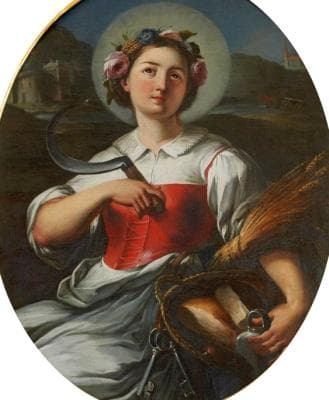
Blessed Notburga
Blessed
Feast Day: September 14
Death: September 16, 1313
Biography
Blessed Notburga, also known as Notburga of Eben, Notburga of Tyrol, Notburga of Rattenberg, Noitburgis, or Nothburga, was born around 1265 in the town of Rattenberg in Tyrolean Austria. She came from a humble peasant family and lived a life dedicated to serving others and working with the poor.
At the age of 18, Notburga began working as a kitchen maid at the house of Count Henry of Rattenberg. Her duties included feeding leftover food to the house swine, as ordered by the count's wife, Ottilia. However, instead of obeying this directive, Notburga chose to give the food to the poor. Upon discovering this, Ottilia saw it as an act of disobedience and dismissed Notburga from her service.
Not discouraged by her dismissal, Notburga found work as a servant for a farmer in Eben am Achensee, Austria. Unfortunately, her mistress, Lady Ottilia, passed away, and Notburga was re-hired by Count Henry. From that point on, she dedicated the rest of her life to serving in his household.
Notburga's devotion to the poor was well-known, and she made it her mission to help those in need. Many miracles are attributed to her throughout her life. One such miracle occurred when her master caught her leaving the house with something hidden in her apron. Suspecting that she was disobeying orders and giving away food, he demanded to see what she carried. However, to protect her, the food and wine had miraculously transformed into wood shavings and vinegar.
Another miraculous event took place when Notburga was working for a peasant farm family in Eben am Achensee. As a condition of her employment, she requested that she be allowed to attend Mass on Saturday nights and on the eve of feast days, without the burden of her chores. On one occasion, the farmer attempted to make her work during one of these times, but Notburga said she would let her sickle decide. She threw it into the air, and to everyone's astonishment, the sickle remained suspended in the air while she went to church.
Shortly before her death, Notburga conveyed her final wishes to Count Henry. She instructed him to place her corpse on a wagon drawn by two oxen and bury her wherever the oxen would stop on their own. Following her instructions, the oxen led the funeral procession to the chapel of Saint Rupert, where Notburga was laid to rest.
Notburga's representation in religious art often depicts her holding an ear of corn, grain, or flowers, with a sickle nearby, symbolizing her devotion to the land and her role as a miracle worker. She is venerated for her selflessness, compassion, and dedication to serving others.
Blessed Notburga's feast day is celebrated on September 14. After the countless miracles reported at her shrine in Eben, Pope Pius IX beatified her on March 27, 1862, officially confirming her cultus. Her legacy continues to inspire and remind us of the power of humble service and love for those in need.